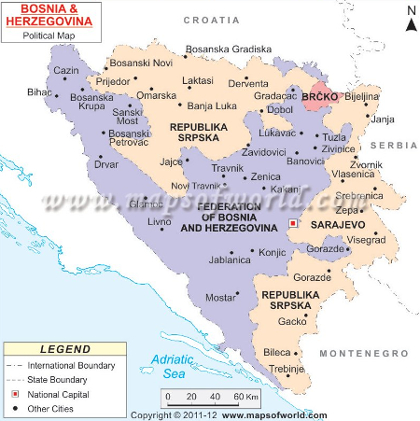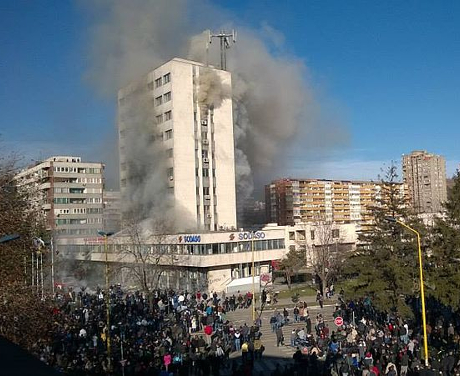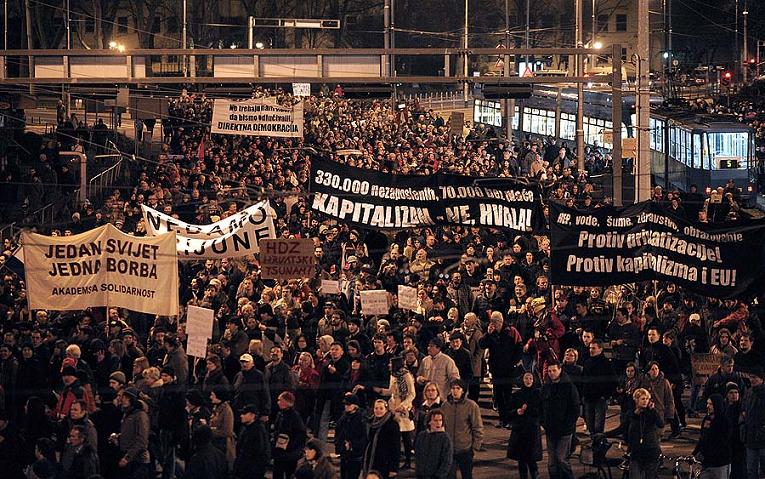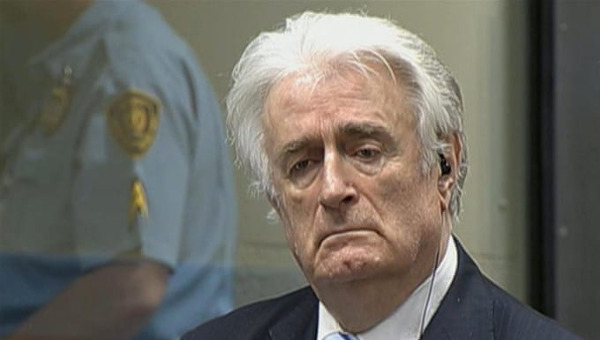On 7 February, government buildings were on fire all over Bosnia and Herzegovina. The people of Bosnia and Herzegovina, silent for a long time, finally decided to speak their minds. And when they did, those were not words – it was a roar. It was fire, stones and heavy fighting with the police. The picture that was the most impressive and symbolic in the first few days of the rebellion was the one of a burning government building in Tuzla, the city where it all began, with the graffiti “death to nationalism” written on it. Since nationalism was a favourite refuge of all the political elites in Bosnia and Herzegovina, used to justify their political and economic oppression, this was indeed a powerful message.

Prime ministers of cantons in Bosnia and Herzegovina started handing in their resignations, one by one. On Sunday, 9 February, the Croatian prime minister Zoran Milanović went to Mostar, a city in Bosnia and Herzegovina with a large Croatian population, to meet with the Croat leaders there, while the president of the Republic of Srpska (the Serbian part of Bosnia and Herzegovina), Milorad Dodik, was summoned to Serbia to meet with the first vice president Aleksandar Vučić (the unofficial leader of Serbia). The reasons were clear. Both the political elites in Croatia and Serbia are afraid, among other things, that what some already call the ‘Bosnian revolution’ may spill over borders.
Undoubtedly, the economic situation in Bosnia and Herzegovina is terrible. The country was once known for its many factories and a strong working-class even the coat of arms of the former Socialist Republic of Bosnia and Herzegovina (part of Yugoslavia) used to feature factory chimneys. Now, many of those factories are closed, the rest is privately owned by foreign corporations or a newly formed capitalist class, and in some of them the workers are working but are not receiving their salaries (which is quite common in post-Yugoslav capitalism). The country has an unemployment rate of about 45 per cent. Neighboring Croatia and Serbia are not in such a bad shape, but still their elites have a lot to worry about as well, since the general situation is also very far from being even mildly satisfactory. For instance, youth unemployment in Croatia is at almost 53 per cent, second only to Greece and Spain in the European Union (EU).
Part of the Global Spring
The explosive and in some cases quite violent rebellion in Bosnia and Herzegovina certainly had its own local reasons – rampant poverty, great inequalities, a huge bureaucratic apparatus and the political and capitalist succubus at the top. However, this uprising in Bosnia is also an integral part of the world uprisings in the last couple of years. After the outbreak of the economic crisis in 2008 and a few years of initial shock, a wave of great protests and uprisings began in 2011 with the Arab Spring, the Indignados in Spain and Occupy Wall Street in the United States. Last year, we saw huge uprisings in Turkey and Brazil. Former Yugoslavia was also not spared of this wave. Already in 2011, there were large ‘Facebook protests’ in Croatia that went on for a month in March. Although politically quite heterogeneous, it was also the first time that openly anti-capitalist messages were displayed in any of the post-Yugoslav countries and the protests in many ways anticipated the Indignados and OWS, sharing with them a clear common Zeitgeist. In March 2012, Slovenia was shaken by a popular ‘Slovenian uprising’ that hugely influenced the public discourse in the country and gave rise to new political forces (such as the potentially promising Initiative for Democratic Socialism). In 2014, it was time for Bosnia and Herzegovina. They were the last to react, but their response was by far the most powerful.
After the rebellion began, almost all analysts have insisted that this had been inevitable and that they had been sure that something like this was bound to happen sooner or later. Of course, this is not true. Although the situation in Bosnia and Herzegovina was indeed catastrophic, prior to all of this most analysts would have claimed that this kind of uprising was impossible because the people are passive, inert and divided by nationalism. But, as is often the case, there was an unpredictable spark and it all grew quickly from there.
Strikes and Protests
The uprising began in Tuzla, a city in the North-Eastern part of the country and a city with a long left-wing and working-class tradition. ‘A different city,’ as is often claimed, because nationalism has never established itself firmly there, unlike the rest of the country. So it is no wonder that it was this city that found itself in the eye of the storm. There, workers of a couple of privatized factories (like Dita, Polihem and Konjuh) had been protesting peacefully for various reasons for quite some time. However, on 5 February they were joined by the city youth, the unemployed and other people and the protest began to escalate, spreading in the following days to most of the country (the most prominent actions occurring in Tuzla, Sarajevo, Zenica, Mostar and Bihać, which are among the largest cities in the country), with the majority of violent clashes and burning occurring on Friday, 7 February.
The protests were clearly spontaneous and had social demands at their roots. Many protesters claimed that they simply had nothing to eat, that they had been unemployed for ages and expressed deep contempt for the criminal political and economic elite. Although the rebellion mostly occurred in parts of Bosnia inhabited by the Muslim Bosniaks (which Croatian and Serbian nationalists were happy and quick to point out), the rebellion was clearly – some provocations, acts of sabotage and stray people aside – social and not nationalist. Of course, the protests are, as is often the case, heterogeneous, e.g. with large numbers of football fans joining the ranks of the militant wing of the protesters. The protests are still occurring mostly in parts of the country where the Bosniaks are predominant, but there are a number of exceptions as well. In Mostar, the city in the South-West of the country, both Croats and Bosniaks were involved in torching the headquarters of both the Croatian and Bosniak main nationalist parties (HDZ and SDA). Ethnic Croats have also protested in Livno and Orašje, while ethnic Serbs organized a couple of smaller scale protests and gatherings in Prijedor, Banja Luka, Bijeljina and Zvornik.

Although the protests are clearly social, the national question, used in their advantage by the political elites (although not completely unfounded in the case of Croats in Bosnia and Herzegovina), still poses a great problem. Many Croats and Serbs in Bosnia and Herzegovina are still suspicious and afraid of the protests taking a different political turn, quoting, for instance, the Islamist turn of the Egyptian revolution (although this kind of scenario is highly unlikely in Bosnia and Herzegovina). This kind of fear is heavily supported by the political elites and the media, which are trying to prevent protests in the Croat and Serbian parts of Bosnia and Herzegovina. In that quest, a wide array of conspiracy theories gained some popularity. Thus, Bosniak nationalists and politicians claim that it is all a plot against Bosniaks, Croat nationalists and politicians claim that it is all a plot against Croats and Serb nationalists and politicians claim that it is all a plot against Serbs. It is also very significant that Croat and Serb nationalist intellectuals and media are silently cooperating in desperately trying to prove that we are dealing with a ‘Bosniak spring’ only.
Still, not everybody is prone to such nationalist propaganda. For instance, one union from Drvar (with most members of Serb nationality) have given their support to the mostly Croat protesters in Livno. Also, the organization of the veteran soldiers of the Serb part of the country have openly threatened their president Milorad Dodik to start dealing with social problems, injustice, privatization crimes etc. or else. However, in Bijeljina (in the Serbian part of Bosnia and Herzegovina) the protesters giving support to the rebellion were met by a counter-protest by the Serb nationalists. The same thing occurred during a solidarity protest in Belgrade in Serbia (at the same time, the police union in Serbia proclaimed that in case the protests were spilling over borders to Serbia, they would not act against the protesters). In Croatia, however, both the left and the right activist forces are organizing the protests in the coming days inspired by what is happening in Bosnia and Herzegovina.
The situation in Bosnia and Herzegovina is very tense right now. Some left leaning intellectuals and public figures are giving support to the protests, but most of the media and the whole political class are united against them. There are a lot of nationalist claims, conspiracy theories, fake manifestos, false statements, fabricated reports and narratives and so on. The elites and regime intellectuals are trying as hard as they can to maintain the status quo. Still, it is obvious that there is a lot of confusion in liberal, conservative and nationalist circles. Their analytical apparatuses and explanatory patterns are not really equipped to deal with this sort of development, since they cannot really perceive the working-class, the unemployed and the poor as really active political subjects. This is all joined by a lot of petty bourgeois moralizing about burned buildings, ‘hooligans,’ ‘unnecessary’ violence and so on. The liberals and conservatives are calling for ‘peaceful and dignified’ protests, in spite of the fact that it is clear that if there had been no violence, none of this would have occurred, and in spite of the fact that the careful coordination of politics and the media have now clearly shown what bourgeois democracy and ‘freedom of the media’ really stand for.
The Workers’ Demands
As always, the media have made a case of pointing out that the protesters do not know what they are doing, that they have no clear goals. This, however, is not true. The demands of the protesters are becoming more and more clear by the day. For instance, the workers and protesters of Tuzla, who are most progressive, politically coherent and articulated, have demanded that the privatizations of Dita, Polihem, Poliolhem, Gumara and Konjuh factories are taken back, health protection for the workers, actions against economic crimes, confiscation of illegally gained wealth, nationalizations of factories and workers’ control, more equal wages, cutting down the privileges of the political elite etc. It is still difficult to tell what will develop from all of this and which part of this is just rhetoric.
Perhaps one of the most interesting and exciting things for the Left is the appearance of the revolutionary organizational body called ‘plenum’ in Tuzla, in the center of the rebellion (where the former government handed in its resignation some days ago). The protesters in the capital Sarajevo and in the town of Zenica are also trying to organize a plenum. The plenum (or the general assembly) is essentially very similar to the original Russian soviets. The protesters are using them in order to reach collective decisions and demands in a direct democratic manner. What is interesting is that the idea of the plenum, as a political body of protest for democratic decision-making, comes from the Croatian 2009 great wave of student occupations, while the Croatian student movement got the idea from the 2006 Belgrade student movement. So this is a fine example of post-Yugoslav left activist cooperation and reciprocal influences.
Some of the demands of the Tuzla plenum, accepted by the remnants of the old government, were to form a new transitional canton government, made up of candidates suggested by the people of the region, but excluding the people already compromised by taking part in previous governments or being members of the old political parties. The newly elected government should also have much lower wages and no additional privileges. The plenum is open for everybody to participate, discuss and vote, except for the members of the old parties and government (which essentially makes this ‘the dictatorship of the proletariat,’ speaking in classical terms). Of course, while this kind of democratic decision-making is highly commendable, for now this seems a temporary thing only and, of course, this kind of decision-making is highly problematic if it is to represent the whole city (or even canton). The 10 February-session of the Tuzla plenum had, according to participants, approximately 200 people present, while the whole population of Tuzla is about 130,000 people.
“The elites will definitely be more afraid of the people in the future, not only in Bosnia and Herzegovina.”
It is impossible to tell how the events will unfold in the future. One thing is certain, though – Bosnia and Herzegovina (and the region as well) will not be the same after this. One could say that already a lot (at least symbolically) has been achieved, especially when one considers the fact that in Bosnia and Herzegovina (and in former Yugoslavia in general) there are no mass (or even larger) left organizations. The ideas and public discourse have already changed. The elites will definitely be more afraid of the people in the future, not only in Bosnia and Herzegovina. One can only hope that all of this will help the formation and growth of progressive forces and organizations in the country.
The dramatic developments in Bosnia and Herzegovina have caused quite a stir in the country itself and in the neighboring countries. However, in the West, the events in Bosnia and Herzegovina were largely ignored. While the Western media devote a lot of attention to the Ukraine, where the EU and the West have concrete vested interests, the social upheaval in Bosnia and Herzegovina (although it is, to be honest, a much smaller country), clearly not something for the European capitalist/liberal elites to rejoice about (especially since neighboring Croatia is the newest member of the EU), is mostly ignored.
However, I find it curious that the Left in Western Europe is also so little aware of what is happening in our region. This is, unfortunately, not really surprising, but it is still not really laudable for the political forces that boast in their internationalism. The Left, especially the Left in the developed western countries, should work much harder on overcoming their own ‘core parochialism.’ The Left, be it intellectual/academic or parliamentary, should be internationalist not just in theory but in practice as well. What is happening in Bosnia and Herzegovina is also very interesting and important for the Left in general. •
Find an open letter of support for citizens of Bosnia-Herzegovina (published on 12 February 2014 on the website of CADTM.
This article first published by ROAR Magazine.



